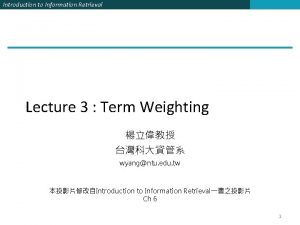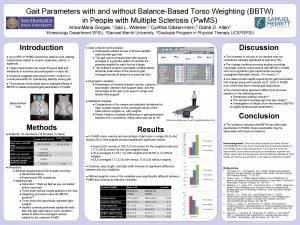The Effect of Poisson Data Weighting on Streak









- Slides: 9

The Effect of Poisson Data Weighting on Streak Camera Diagnostics B. Cerio, R. Holtzapple

MOTIVATION Measurement of longitudinal beam dynamics will be critical in CESR-TA operation. In CHESS and CESR-c operation, a Hamamatsu Dual-Sweep Streak Camera was used to measure longitudinal beam size and position. With a synchroscan unit tuned to 142. 9 MHz, the camera was capable of measuring with 14 ns resolution. In CESR-TA operation, bunches will have 4 ns spacing, necessitating a synchroscan unit upgrade. In preparation for CESR-TA operation, the effect of weighting the camera signal according to Poission statistics is examined.

Calculation of Amplification Factor peak signal

Calculation of Error Plot of weighting factor for a single bunch. Large signal corresponds to small weight. Movie of fits for 12 bunches. Error bars are small, but χ2/ndf is still less than one, indicating that the data is strongly Gaussian.

Does weighting the data change the measured bunch length? Unweighted Train 2 Train 9 Weighted • Fitting to weighted data does not change the measured bunch length. • There is no bunch lengthening along the beam (data was taken parasitically during CHESS 9 x 6 operation).

Does weighting the data change the measured longitudinal position? Unweighted Single Train 2 14 Trains Weighted • Fitting to weighted data does not change the measured longitudinal position. • In conclusion, Poisson weighting of streak camera data does not significantly change quantities of interest.

Bunch Length in CHESS There is no bunch lengthening along either train. Also, bunch length in the two trains are comparable, suggesting that there is no bunch lengthening along the beam. There is no evidence of instability.

Bunch Position in CHESS Bunch position within a train is constant. Error values are the standard deviation divided by the number of data points. Since there were 250 points in both sets, based on the standard deviation in position, train 2 showed more longitudinal motion than train 9.

Train Position in CHESS Turn 1 Turn 2 The confidence values are the statistical error. Since both data sets have the same number of points, it is a measure of longitudinal motion. Motion seems to be constant along beam, suggesting that the beam is stable.

















